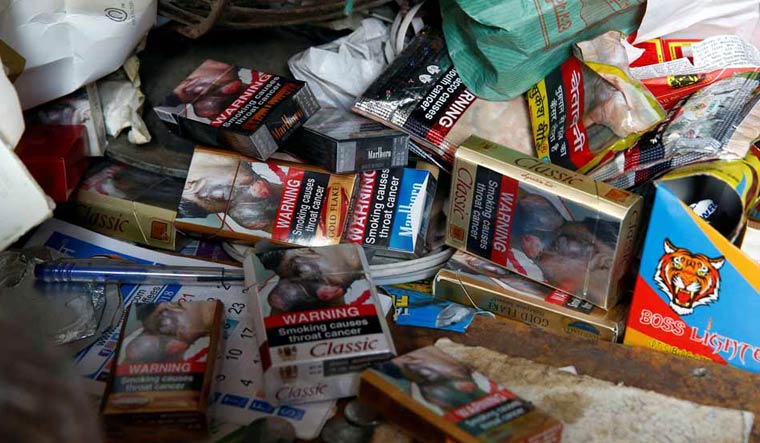Recently, a premier law school of the country recommended increasing the legal age for purchase of tobacco in India, from the present 18 years to 21 years, in the hopes of preventing early initiation to regular use. It can possibly work if we can control sale of tobacco to those under-age.
How can we restrict consumption by minors?
It is estimated that 14.6 per cent of students (13-15 years of age) consume tobacco via cigarettes, beedis, hookah or smokeless tobacco in India. To check under-age smoking, we need to prevent vendors from selling tobacco products to children or prevent them from selling the products altogether.
Nearly 4 crore small kiosk owners and roadside vendors sell tobacco goods across the country. The challenge of ensuring no sales to those under-age will be an administrative and monitoring one, as in the case of alcohol, which is sold at much fewer outlets.
However, amendments to the principle law governing tobacco use in India— COPTA Act of 2003—could have a significant impact. Steps such as banning point-of-sale advertisements, abolishing designated smoking areas at airports and so forth and uniformly extending taxation to all tobacco products, including beedis, would be in the positive direction.
There is also a socio-economic challenge that needs to be focused upon with urgency to effectively tackle tobacco use.
The socio-economic challenge
Sellers; workers involved in processing, manufacturing and rolling of tobacco; tobacco farmers; and farm labourers form a 45.7 million-strong population, which is dependent on the industry for livelihood. Tobacco is a highly profitable product. It can grow in relatively infertile soil and is also labour intensive, providing massive employment. As such, there is fierce resistance among those working in the tobacco industry in switching to alternate crops/cropping patterns or in re-skilling themselves for other job roles.
This policy challenge in countering tobacco use, therefore, has become a question of both lives and livelihoods. The tobacco companies often use livelihood creation as a justification to continue cultivation. However, in order to negate this narrative, it is imperative that efforts to bring cultivators and workers out of the industry are redoubled.
Initiatives and success so far
Due to the schemes launched by the Central and state governments, land under tobacco cultivation has diminished by 71,000 hectares in the last five years.
The government is actively intervening to reduce the production of tobacco and incentivise people to switch to alternatives. Recognising the health risks of tobacco use, it has deliberately kept the incidence of taxation on tobacco high and continues to increase it each successive year. The WHO has also called taxation the single most effective policy tool to reduce tobacco use.
In November 2019, India also banned all electronic cigarettes and other ENDS products.
The government has formulated provisions for the distribution of high-quality seeds of alternate crops and financial assistance to farmers to encourage them to take up substitute farm and non-farm activities.
Because of the high economic worth of tobacco, all the alternatives offered need to have comparable returns. Additionally, the employment generation would have to cater to entire communities of people. The main dependencies on this industry come from small and marginal farmers, rural women, tribal youth and weaker sections of society.
Role of private sector and civil society
Our efforts will get a boost with active participation from the private sector and civil society. There are already several NGOs targeting consumer behaviour aspects of tobacco use. Private health researchers are also working actively to identify substitutes that can help in countering nicotine addiction, particularly in children.
For the producers, social and CSR initiatives like rural entrepreneurship or cooperative assistance involving cultivation of sugarcane, bamboo, Bengal gram, soya bean and so forth would help enhance the viability of these crops. Directing cultivated tobacco increasingly towards non-ingestible derivatives like industrial chemicals, soaps and paints would help in reducing supply for cigarettes, smokeless tobacco and so forth.
Scientific research and public health impact assessment on potential alternates like cannabis—which has now been removed from the United Nations list of illegal narcotics at the recommendation of WHO—can also be explored. If supported by social and health impact assessments, probably India could look at the plant with significant financial, industrial and medicinal potential.
At the same time, the state must also focus on curbing the proliferation of smuggled cigarettes, which account for 25 per cent of all cigarette sales and does not use Indian tobacco, causing major losses to farmers. Banning of sale of loose cigarettes is a matter of urgency.
Conclusion
While smoking has been prevalent in India since ancient times in various forms, tobacco was introduced by the Portuguese to India only at the start of the 17th century. From cultivation in two districts of Gujarat at the time, today India has 400,000 hectares of land under tobacco cultivation, catering to over 26 million consumers across the country.
Tobacco kills 1.3 million Indians annually and significantly increases risks of oral, pulmonary and cardio-vascular ailments including cancers, tuberculosis (TB) and multi-drug-resistant tuberculosis (MDR-TB). It is time for government, private sector and civil society to come together and display renewed efforts to assist all the stakeholders in the industry.
(Rajiv Pratap Rudy is the Member of Parliament from Saran, Bihar. Ishaan Ajay is an independent policy analyst.)







